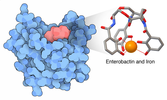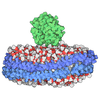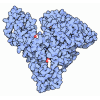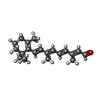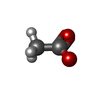[English] 日本語
 Yorodumi
Yorodumi- PDB-5f7g: Crystal structure of the Q108K:K40L:T51V:R58Y:Y19W:Q38L mutant of... -
+ Open data
Open data
- Basic information
Basic information
| Entry | Database: PDB / ID: 5f7g | ||||||
|---|---|---|---|---|---|---|---|
| Title | Crystal structure of the Q108K:K40L:T51V:R58Y:Y19W:Q38L mutant of human Cellular Retinol Binding Protein II in complex with All-trans-Retinal at 1.48 Angstrom Resolution | ||||||
 Components Components | Retinol-binding protein 2 | ||||||
 Keywords Keywords | TRANSPORT PROTEIN / all-trans retinal / retinal light absorbing pigment / wavelength regulation | ||||||
| Function / homology |  Function and homology information Function and homology informationvitamin A metabolic process / molecular carrier activity / retinoid binding / retinal binding / retinol binding / epidermis development / fatty acid transport / Retinoid metabolism and transport / fatty acid binding / nucleus / cytosol Similarity search - Function | ||||||
| Biological species |  Homo sapiens (human) Homo sapiens (human) | ||||||
| Method |  X-RAY DIFFRACTION / X-RAY DIFFRACTION /  SYNCHROTRON / SYNCHROTRON /  MOLECULAR REPLACEMENT / Resolution: 1.48 Å MOLECULAR REPLACEMENT / Resolution: 1.48 Å | ||||||
 Authors Authors | Nosrati, M. / Nossoni, Z. / Geiger, J.H. | ||||||
 Citation Citation |  Journal: To Be Published Journal: To Be PublishedTitle: Crystal structure of the Q108K:K40L:T51V:R58F mutant of human Cellular Retinol Binding Protein II in complex with All-trans-Retinal after 24 hours of incubation at 1.54 Angstrom Resolution Authors: Nossoni, Z. / Nosrati, M. / Wang, W. / Berbasova, T. / Vasileiou, C. / Borhan, B. / Geiger, J.H. | ||||||
| History |
|
- Structure visualization
Structure visualization
| Structure viewer | Molecule:  Molmil Molmil Jmol/JSmol Jmol/JSmol |
|---|
- Downloads & links
Downloads & links
- Download
Download
| PDBx/mmCIF format |  5f7g.cif.gz 5f7g.cif.gz | 75.8 KB | Display |  PDBx/mmCIF format PDBx/mmCIF format |
|---|---|---|---|---|
| PDB format |  pdb5f7g.ent.gz pdb5f7g.ent.gz | 55.6 KB | Display |  PDB format PDB format |
| PDBx/mmJSON format |  5f7g.json.gz 5f7g.json.gz | Tree view |  PDBx/mmJSON format PDBx/mmJSON format | |
| Others |  Other downloads Other downloads |
-Validation report
| Summary document |  5f7g_validation.pdf.gz 5f7g_validation.pdf.gz | 791.8 KB | Display |  wwPDB validaton report wwPDB validaton report |
|---|---|---|---|---|
| Full document |  5f7g_full_validation.pdf.gz 5f7g_full_validation.pdf.gz | 794 KB | Display | |
| Data in XML |  5f7g_validation.xml.gz 5f7g_validation.xml.gz | 14.9 KB | Display | |
| Data in CIF |  5f7g_validation.cif.gz 5f7g_validation.cif.gz | 20.8 KB | Display | |
| Arichive directory |  https://data.pdbj.org/pub/pdb/validation_reports/f7/5f7g https://data.pdbj.org/pub/pdb/validation_reports/f7/5f7g ftp://data.pdbj.org/pub/pdb/validation_reports/f7/5f7g ftp://data.pdbj.org/pub/pdb/validation_reports/f7/5f7g | HTTPS FTP |
-Related structure data
| Related structure data |  5f58C  2rctS C: citing same article ( S: Starting model for refinement |
|---|---|
| Similar structure data |
- Links
Links
- Assembly
Assembly
| Deposited unit | 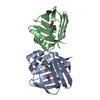
| ||||||||
|---|---|---|---|---|---|---|---|---|---|
| 1 | 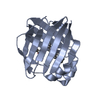
| ||||||||
| 2 | 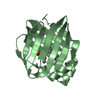
| ||||||||
| Unit cell |
|
- Components
Components
| #1: Protein | Mass: 15594.554 Da / Num. of mol.: 2 / Mutation: Q108K, K40L, T51V, R58Y, Y19W, Q38L Source method: isolated from a genetically manipulated source Source: (gene. exp.)  Homo sapiens (human) / Gene: RBP2, CRBP2 / Plasmid: pET17b / Production host: Homo sapiens (human) / Gene: RBP2, CRBP2 / Plasmid: pET17b / Production host:  #2: Chemical | #3: Chemical | #4: Water | ChemComp-HOH / | Has protein modification | Y | |
|---|
-Experimental details
-Experiment
| Experiment | Method:  X-RAY DIFFRACTION X-RAY DIFFRACTION |
|---|
- Sample preparation
Sample preparation
| Crystal | Density Matthews: 2.01 Å3/Da / Density % sol: 38.93 % |
|---|---|
| Crystal grow | Temperature: 298 K / Method: vapor diffusion, hanging drop / pH: 4.5 Details: 25% PEG 4000, 0.1 M Ammonium Acetate, 0.1 M sodium acetate pH = 4.5 PH range: 4-4.8 |
-Data collection
| Diffraction | Mean temperature: 100 K |
|---|---|
| Diffraction source | Source:  SYNCHROTRON / Site: SYNCHROTRON / Site:  APS APS  / Beamline: 21-ID-D / Wavelength: 1.0781 Å / Beamline: 21-ID-D / Wavelength: 1.0781 Å |
| Detector | Type: MARMOSAIC 300 mm CCD / Detector: CCD / Date: Dec 8, 2012 |
| Radiation | Protocol: SINGLE WAVELENGTH / Monochromatic (M) / Laue (L): M / Scattering type: x-ray |
| Radiation wavelength | Wavelength: 1.0781 Å / Relative weight: 1 |
| Reflection | Resolution: 1.48→50 Å / Num. all: 160420 / Num. obs: 43022 / % possible obs: 95.5 % / Redundancy: 3.9 % / Net I/σ(I): 37.3 |
| Reflection shell | Resolution: 1.48→1.5 Å / Redundancy: 3.9 % / Rmerge(I) obs: 0.586 / Mean I/σ(I) obs: 2.37 / % possible all: 93.6 |
- Processing
Processing
| Software |
| |||||||||||||||||||||||||||||||||||||||||||||||||||||||||||||||||||||||||||||||||||||||||||||||||||||||||
|---|---|---|---|---|---|---|---|---|---|---|---|---|---|---|---|---|---|---|---|---|---|---|---|---|---|---|---|---|---|---|---|---|---|---|---|---|---|---|---|---|---|---|---|---|---|---|---|---|---|---|---|---|---|---|---|---|---|---|---|---|---|---|---|---|---|---|---|---|---|---|---|---|---|---|---|---|---|---|---|---|---|---|---|---|---|---|---|---|---|---|---|---|---|---|---|---|---|---|---|---|---|---|---|---|---|---|
| Refinement | Method to determine structure:  MOLECULAR REPLACEMENT MOLECULAR REPLACEMENTStarting model: 2RCT Resolution: 1.48→27.288 Å / SU ML: 0.36 / Cross valid method: FREE R-VALUE / σ(F): 1.99 / Phase error: 24.78 / Stereochemistry target values: ML
| |||||||||||||||||||||||||||||||||||||||||||||||||||||||||||||||||||||||||||||||||||||||||||||||||||||||||
| Solvent computation | Shrinkage radii: 0.6 Å / VDW probe radii: 0.9 Å / Solvent model: FLAT BULK SOLVENT MODEL / Bsol: 48.769 Å2 / ksol: 0.408 e/Å3 | |||||||||||||||||||||||||||||||||||||||||||||||||||||||||||||||||||||||||||||||||||||||||||||||||||||||||
| Displacement parameters |
| |||||||||||||||||||||||||||||||||||||||||||||||||||||||||||||||||||||||||||||||||||||||||||||||||||||||||
| Refinement step | Cycle: LAST / Resolution: 1.48→27.288 Å
| |||||||||||||||||||||||||||||||||||||||||||||||||||||||||||||||||||||||||||||||||||||||||||||||||||||||||
| Refine LS restraints |
| |||||||||||||||||||||||||||||||||||||||||||||||||||||||||||||||||||||||||||||||||||||||||||||||||||||||||
| LS refinement shell |
|
 Movie
Movie Controller
Controller



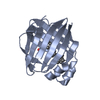

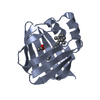


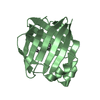


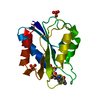

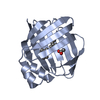

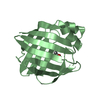
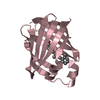
 PDBj
PDBj
